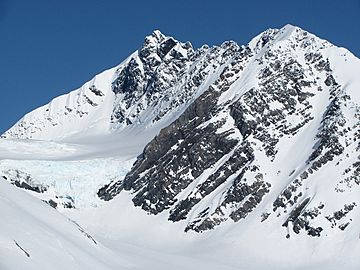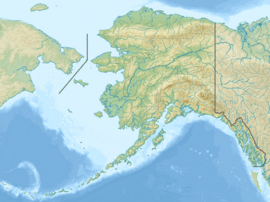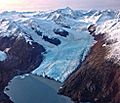Carpathian Peak facts for kids
Quick facts for kids Carpathian Peak |
|
|---|---|

Carpathian Peak
|
|
| Highest point | |
| Elevation | 6,000+ ft (1,830+ m) |
| Prominence | 3,000 ft (910 m) |
| Isolation | 8.06 mi (12.97 km) |
| Parent peak | Isthmus Peak (6,532 ft) |
| Geography | |
| Location | Chugach National Forest Kenai Peninsula Borough Alaska, United States |
| Parent range | Kenai Mountains |
| Topo map | USGS Seward C-5 |
| Climbing | |
| First ascent | May 1959 by Keith Hart, Ted Barrett, and Mat Nitsch |
Carpathian Peak is a tall mountain peak, about 6,000 feet high, located in the Kenai Mountains in Alaska, United States. You can find it in the Chugach National Forest, about 8 miles (13 km) southwest of Whittier, Alaska. It sits on a narrow strip of land connecting the Kenai Peninsula, where the Kenai Mountains meet the Chugach Mountains.
Even though it's not the tallest mountain, it looks very impressive! Its eastern side rises straight up from the ocean at Blackstone Bay in Prince William Sound. The closest taller mountain is Isthmus Peak, about 8 miles (13 km) to the south. Another nearby peak is Bard Peak, about 5 miles (8 km) northeast.
The mountain's name became official in 1959, thanks to the United States Geological Survey. In May 1959, three climbers named Keith Hart, Ted Barrett, and Mat Nitsch were the first to reach its top. They suggested the name to honor the Carpathian Mountains in Mat's home country. At that time, his homeland was a place where people didn't have much freedom, and they wanted the name to be a symbol of freedom.
Climate and Glaciers
Carpathian Peak is in a subarctic climate zone. This means it has long, cold, and snowy winters, but mild summers. Temperatures can drop very low, sometimes below −20 °C (or −4 °F). When you add in the wind, it can feel even colder, below −30 °C (or −22 °F).
This cold climate helps keep several glaciers alive around the mountain. You can find the Skookum Glacier on its west side, Portage Glacier to the north, and the Spencer Glacier on its south and east sides. If you want to visit or climb this peak, the best time for good weather is usually from May through July.
Images for kids




